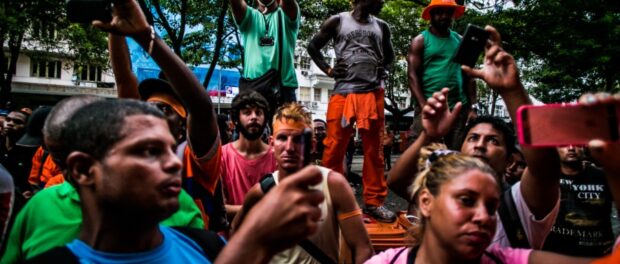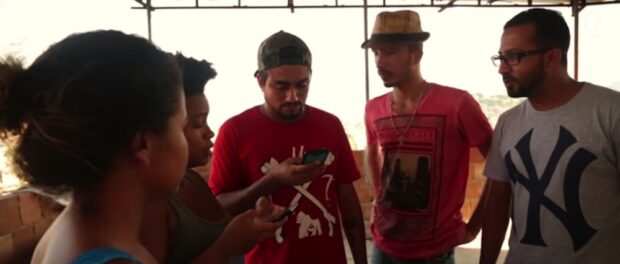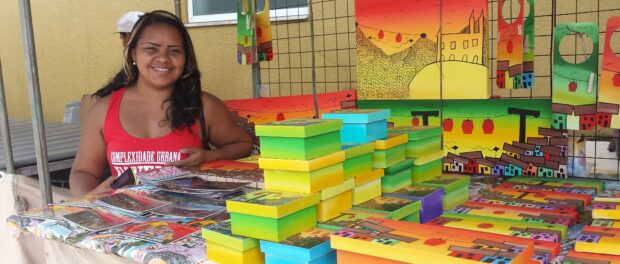
When foreign journalists visit Rio de Janeiro wishing to report on favela community news, they quickly come to find themselves relying on social media. Many are surprised at how Brazil in general and favela residents in particular have not only embraced social media, but use it vigorously for sharing news about their communities. As reported last year, favelas have a higher number of Internet users than the ‘asphalt’ or formal city. The Internet in favelas is mainly accessed using mobile phones, and often utilizing free wifi. The mobile phone is, argues Thamyra Thâmara of the GatoMÍDIA collective, an essential tool for addressing inequalities and especially for favela youth: “No event occurs that is not passed through the lens of their android phone.”
Many favelas have individual community members who spread updates, for example on electricity shortages, warnings of police activity or flooding, and community news like the opening of a new restaurant, event or protest. From WhatsApp, so loved by Brazilians that it is affectionately called “zap zap” (and for whom the world came to a halt for 24 hours in December when the service was shut down) to Twitter and Facebook (where Brazilians constitute both sites’ #2 users worldwide) and Snapchat, some influential residents have formed strong followings and their use of social media has made them pillars of the community. And young Brazilians are those worldwide spending the most time on mobile devices.
In Complexo do Alemão, in Rio’s North Zone, Mariluce Mariá Souza, an artist and community activist, has reached the limit of friends allowable by Facebook as her role as an essential news source for the favela has become well known. She also runs a WhatsApp group for residents and journalists. Mariluce has gone on to gain recognition for her work and to speak at Stanford University’s Educational and Entrepreneurial Initiatives to Support Youth in Places of Violence conference. Mariluce is only one example of an awe-inspiring movement of Rio residents taking on the responsibility to inform and share news from the favelas that is often overlooked or seen as inaccessible by local and foreign media.
Favela social media roundup for 2015
2015 stood out with major breakthroughs in the role played by social media in promoting and sharing grassroots news from Rio’s favelas. Citizen journalists, concerned community members and activist groups have been using social media for many years to push out news including in Complexo do Alemão, Providência and Complexo da Maré among others. However, 2015 saw this intensify to the point that social media bridged the gap from, and went on to directly influence, mainstream and international news.
The extent to which an average citizen could now impact the news agenda became incredibly clear in the case of 17-year-old Eduardo Felipe Santos Victor in Providência. On Tuesday, September 29, police shot Eduardo dead. A favela resident caught the police on camera planting a gun on his body and firing it to frame him by leaving traces of gun powder. The graphic video, shared shortly after the incident on Facebook, quickly went viral. Getting widely shared and tweeted on Twitter within a matter of hours, the video and its message were quickly picked up by national news and soon after internationally by the BBC and The Telegraph. The vital role of social media and mobile use in this case was highlighted in The Guardian‘s report, pointing out that it is only “when incidents are filmed that justice is done.”

The woman that recorded the video has reportedly been threatened by police, and has been offered protection by the Civil Police’s Homicide Division. Her brave actions had real-world implications for Eduardo’s case as five police officers were quickly arrested, and have empowered future community witnesses to continue to document and share incidents in their favelas.
Favela residents are not just widely utilizing current social networks, but are also ahead of the curve in snapping up new social media trends. 2015 saw Periscope hit the market and this live video-streaming app was quickly taken up by forward-thinking favela journalists. The automatic link with Twitter allows Periscope to easily fit in with the daily flow of news from favelas. This allows individuals like Raull Santiago and other members of the media collective Coletivo Papo Reto from Complexo do Alemão to use it for interviews, live accounts of police action and news commentary.
Coletivo Papo Reto are at the forefront of using social media, innovative video techniques and community organizing to make a measurable impact in their community. They have received international recognition for their work using citizen journalism and video to hold police accountable for their actions, including winning the 2015 International Philanthropy Award.
In 2015 Rio residents continued to expand their already intense use of WhatsApp, by creating diverse groups to share real-time news updates. The app’s groups function allows favela residents to share news for free immediately within their communities and across broad networks of supporters. Some residents are also using WhatsApp to connect with local journalists and correspondents to ensure news is picked up instantly. WhatsApp is such an accepted tool for news in Rio that Brazilian newspaper O Dia has been using WhatsApp since 2014 to receive tips and news. In 2015 Globo’s RJTV news joined the network offering readers the chance to send in photos and videos through both WhatsApp and the lesser-used Viber.
In 2015 we also saw the growth of the use of event and campaign organizing on social media using hashtags, including Coletivo Papo Reto’s #TáTudoErrado (#EverythingIsWrong) campaign and protest events, Complexo do Alemão’s collective crowdfunding campaign #TodosPeloAlemão (#AllForAlemão), Vila Autódromo‘s campaigns #VivaVilaAutódromo and #RioSemRemoções (#RioWithoutEvictions) and their #OcupaVilaAutódromo events. These hashtags effectively mobilized residents behind the respective causes, as well as gaining support from other favela communities, broader civil society movements and local and international media.
What might happen in 2016
2016 offers enormous potential for change in Rio. With the Rio 2016 Olympic and Paralympic Games just around the corner favela residents have increased opportunities to gain international news attention, but also potentially face increased threats, with forced evictions and police brutality intensifying in the lead-up to the mega-event.

In the world of social media, new apps and functionality may prove useful to favela residents. Blab, a video chat app that allows group interactions with up to four people that anyone can watch in real-time, may provide interesting potential uses for favela organizers. In 2015 we saw multiple examples of favela communities supporting one another via social media by sharing and debating events in one another’s communities. Such an app could enable separate communities sharing common concerns to work together and put out collective social media videos. In general, live-streaming of video will only get bigger and improve in quality in 2016. In fact, it is becoming so mainstream that Facebook began testing its own live video feature in early December.
Using cell phones for filming and documenting incidents, especially police violence and forced evictions, was recognized internationally as an important movement in 2015 and will continue to grow in 2016. An initiative between Witness, Coletivo Papo Reto and top New York coders hopes to bring out a new app, CameraV, in 2016. CameraV is being beta tested now with the aim of allowing users to securely film any incident. The app will embed sensor data from the smartphone into the pixels of a captured image or film, allowing for new evidentiary and authentication standards. This may mean that the use of citizen film as evidence in criminal proceedings is strengthened, hopefully encouraging witnesses to feel more secure collecting and sharing their video evidence.
At the same time, the power of social media is increasingly viewed as a threat by the government. WhatsApp was shut down on December 17, an outage that was initially planned for 48 hours but shortened to 24 hours after nationwide outrage. This drastic move by the courts appears to have been in response to WhatsApp’s refusal to release personal data of users who were being investigated by the Federal Police. In a country with 100 million WhatsApp users, the move was a strong one and creates concerns about the future stability of the social media accounts that so many rely on.
Over the past month, starting with TechCrunch and most recently in TIME, news has circulated internationally about the Brazilian Congress’ plan to roll back elements of the celebrated 2014 Marco Civil, Brazil’s Internet “Bill of Rights” which included rights for Internet users. The proposed changes include requiring all websites to store users’ personal details for up to three years and provide access to police. This kind of “big brother” access would have massive ramifications for social media use, citizen journalism and Brazil’s position at the forefront of Internet use. As social media forecasters expect WhatsApp, YouTube and Facebook to keep growing in Brazil, this issue will be the big one to watch in 2016, with the situation intensifying as politicians concerned with a growing public backlash fight to restrict transnational Internet companies and user rights.
Whatever else 2016 may bring, favela residents will certainly continue utilizing social media for news, protection and organizing, and to share their stories with the world.

